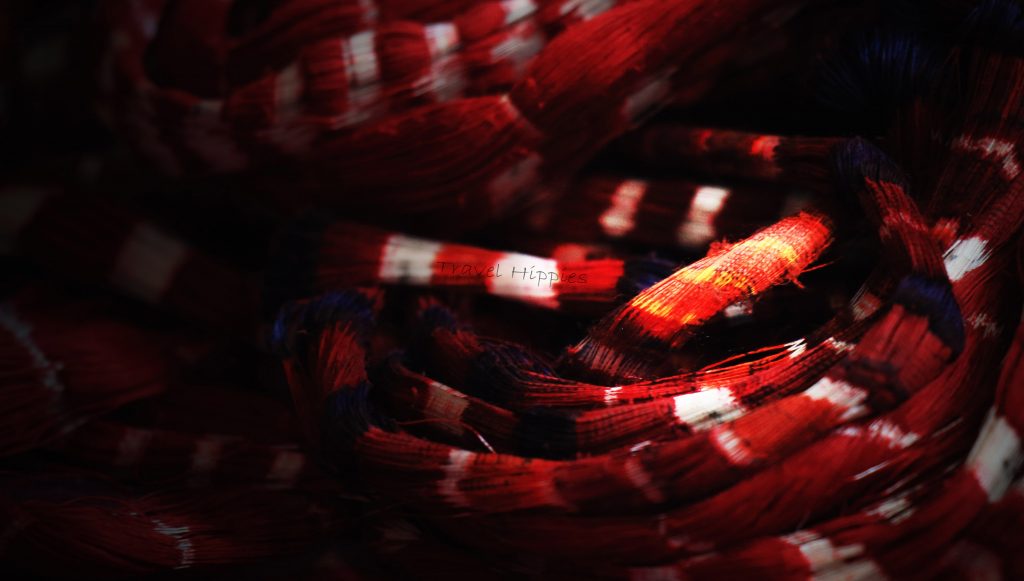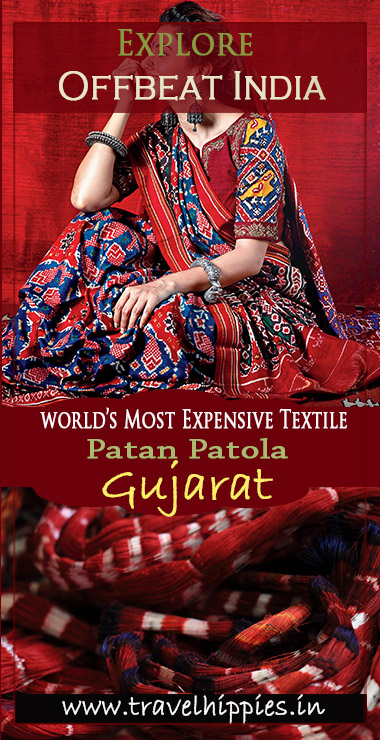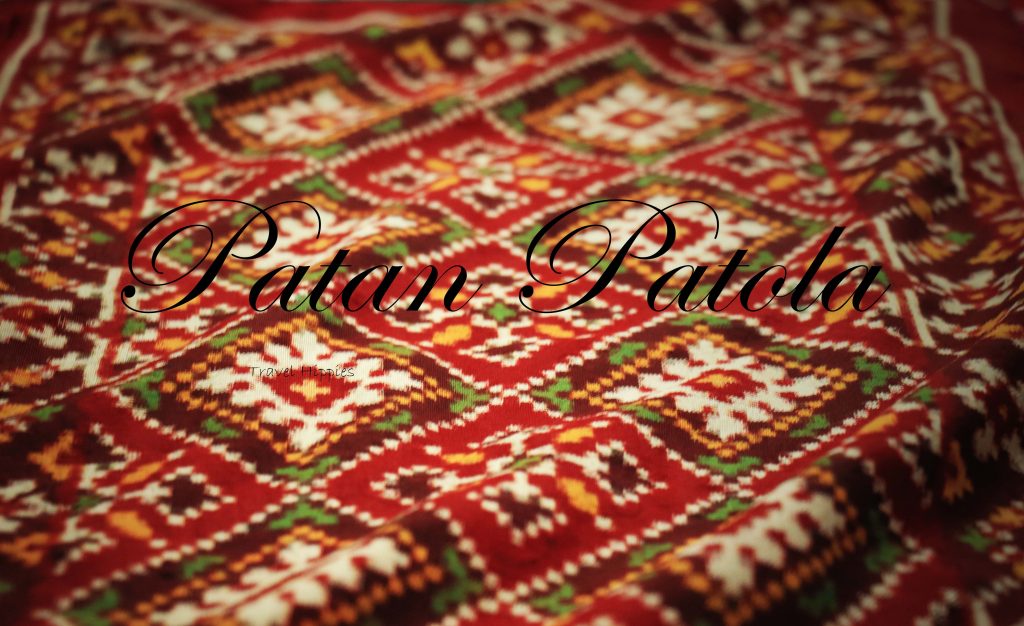Being a Garba crazy child in Gujarat, I used to hum the Gujarati folksongs mentioning the expensive Patolas of Patan. Back then, I hardly cared about what Patan patola Saree was and why were they so expensive. I hardly cared to even know about it until we planned a road trip to North Gujarat covering Modhera, Patan, and Sidhpur.
The moment you enter the city of Patan, you would be welcomed by the ruins of the ancient fort. The giant gates appear to be a frame showing the mildly sunny streets of old Patan. And the men clad in white Gujarati style ‘Chorno’ (chudidaar pant) and ‘Kediyu’ (shirt with flare) with a paghdi on their head would be seen sitting in the courtyard. Most of them can be seen busy with their games and discussions.
At the main crossroad towards the Patan Step Well, a modern house with a traditional look wouldn’t fail to grab your attention. They have converted the house into a museum that familiarizes the tourist with the resplendent art of Patola making.
Patan Patola History: Its Journey From the South to the West
Once upon a time 700 Salvi families that were involved in the Patola work inhabited Patan. Now, only two Salvi families are devoted to the efforts of preserving this art. Maharaj Kumarpal of Patan, whose life-stories are the ribs of Gujarati literature, was the follower of Jainism.
As per the belief, never once did he go to the temple repeating the same Patola sari wrapped as a dhoti. Every day a fresh Patola was imported from Maharashtra.
After his conflict with the Maratha kingdoms, Siddhraj Jaisinh couldn’t get the proper supply of the Patola. Moreover, he also doubted the purity of Patola. That was the time when Maharaj invited the 700 Salvi families who were the Digambar Jains from the Jalna district of Maharashtra. Maharaj had established a special colony called Salvivaas for them. The silk was brought from China and south India. The Salvis used to weave the saris based on the designs suggested by the King.

Birth and Prevalence
The origin of the Patolas is said to have been in South India. Patta is a huge long cloth which is called patola in Telugu. Even the traveler Ibn Batuta mentions about the Patolas being gifted in the courts of the Southern Kingdoms.
The Patola designs can even be seen in the Ajanta paintings and the Palace in Kochi. However, it has now officially received the geographical identity from Patan, Gujarat. Most of the current designs were invented 900 years ago in Patan.
Apparently, the art died in all the other places except in Gujarat.
The Meaningful Designs of the Sari – The Types of Patan Patola
Panchanda Design
‘Panchanda’ design is another favorite of the Gujaratis. It has the beetle nut leaves design surrounding a white circle which was a ‘yantra’ worshipped by the King. The designs, the way it is believed even in the Vastu techniques, have the power to evoke the positive energy. And the same logic has been implied in the Patolas.

Naari Kunjar Design
Patolas are also the best gifts given in the marriages. ‘Nari Kunjar’ design involves the parrots, elephants, flowers, butterflies, peacocks, and creepers in it. It is considered an auspicious gift to married women. The designer elements signify the prosperity of married life. Etymologically, the word Nari Kunjar means the garden of the woman. (which is her in-law’s place that the lady of the house nourishes with her love, as per the local belief).
Navratna Patolas
The aristocratic tradition of the elite class was to combine the attire of Patola with expensive ‘Chudlas’ (Bangle set). Chudlas were studded with diamonds, emeralds, ruby, and sapphire. The gemstones are believed to have the energies to bring prosperity to its wearer. The same concept has been implied in the Nav-Ratna (nine gems) design of Patolas.
Bhat Patolas
The design involving a series of beetle nut leaves all across the sari is called ‘Paan Bhat’ (पान भाट). A beautiful custom of Gujarat involves carrying tons of gifts in a basket on an auspicious occasion. And this was mainly prevalent among the royal class. The same tradition gave birth to the ‘Chhab Bhat’ (छाब भाट). A round circular shape seems to carry the designs of the flowers, bouquets, and vase.
Other types
The ‘Vohri Gaj Design’ has more of geometric shapes and is loved by the Bohri Muslim community of Gujarat.
The Patola designs are thus based either on Astro-logic, nature, and traditions. Some other designs are: ‘Vad Mogra’, ‘Laheriya Bhat’(Wavy Design), Phul Bhat (Flower design), and Sankli Bhat (Chain design). Srikar is the most auspicious one worn by both Jain men and women in different styles. The design represents the elephant emblem of the Jain Tirthankara Ajitnathswami.
When Patolas went International
India, as we all know, was known as the Golden Bird. The craftsman and the weavers earned through the flourishing international markets on the silk route.
The Indonesians were the biggest importers of the Patolas weaved out of Mawa (Indonesian word) ‘God’s Creation’, a word for silk. Even the kings of India are supposed to have been wearing it for temple visits. The silk, designs, and colors bring them closer to the divinity and are also said to be giving them vigorous power.
The elite class of the countries like Malaysia, Java, Sumatra loved these patolas. The holy silk was believed to be their life savior in the battles. The popularity of this divine art had also reached till Samarkand and they were in high demand even in Samarkand and Rome.
That was certainly a glorious past. Now, as the Patola art is on the verge of declining, the designers like Gaurang Shah are taking great efforts in bringing it to the current fashion stream. Kiran Kher had set the stage on fire during her ramp walk for Patola art in the Lakme Fashion Week. From Sonia Gandhi to Neeta Ambani, all the elite class women have a number of Patola designs in their wardrobe collection.
A few members of the Salvi families of Patan have also been exporting the designer saris to London.
The Arduous Procedure
Long threads, symmetrical arrangements, forming the knots as per the design graph and then dye it with the natural colors. This is how simple, the procedure sounds and the actions seem exactly the opposite. More the use of natural colors, threads, and traditional methods, better is the lifespan and higher the price.

In one of the workshops of the Salvi family, I got to see a Patola that was 150 years old! The color was bright, vibrancy intact, designs untouched, the only defect was that the lack of maintenance had torn the cloth. And thus, the Gujarati saying aptly says, “Padi Patole Bhat, Faate pan Fite Nahi” (पड़ी पटोळे भाट, फाटे पण फीटे नहीं). The saying states that the Patola Sari may tear off but the design can never fade.
The Making of Patolas
The making of just one Patola can take 3 to 6 months. And three different laborers with different skills have to be employed in the making of just one sari. The designer gives the design graph the way it is given for the weaving of Chanderi saris. Then the thread is selected as per the demand of the customer. It ranges from cotton, Muga, Tasar, cotton-silk, South Indian Silk to Pure Chinese Silk (Mulberry).
The threads are first arranged in a set of a particular number, and then they are tied as per the design. The warp and weft yarns should be designed in such a way that when both of them are woven to form a textile. And also create the exact design. This is called double ikkat, the most difficult of all kinds of weaving in India.

The yarns are then painted considering the color patterns in the graph. On asking about how they determine the spaces to be kept in between the knots, the artist in the house gave an extremely mathematical explanation that completely bounced off the left hemisphere of my brain.
Looking at the confused face of mine, he immediately clarified that it might take months for any new person to understand the method. And seriously, looking at work he showed I wondered which brilliant mind had such a sharp brain to create a masterpiece by using math, art, and science!
When the painted yarns are ready, they are spread on the looms, fixed properly and are separated using a needle so that a flawless design is visible. It is said that the double ikkat has such an unblemished finishing that even the makers fail to identify the upper and the lower side. The sari can be worn on both sides. And this art was developed thousands of years ago!

Double Ikkat textile production is alive only in three countries in the world. India’s Patan Patolas are in exalted position presiding Japan’s Kasuri Production in Okinawa and Indonesia’s Tenganan village in Bali. In fact, most of Indonesia’s designs are adapted from the Patan Patola designs. And the traditional designs of Patolas also has a high influence on the Japanese art of making Kasuri cloth.
The Colours of Nature aren’t so artificially bright

While entering the storage room I really had to stop breathing due to an irksome odor. I could immediately recognize the cause of it. The odor erupted from the artificial dye. The threads colored using it looked strikingly bright. Whereas the threads kept in the other corner had a dusky shade but looked soothing to the eyes.
These natural colors are made out of natural elements like dried pomegranate skin, dried turmeric, indigo and kaatha (a fruit). And they last forever.
Patolas, just like the precious ornaments, was the dream of every lady in the bygone era and so is now.
This might also interest you..
Vohra Wad; A European Colony in an Indian Town
Backpacking in Gujarat; Think beyond the Rann of Kutch
Pin it Now to Refer it Later

Follow me on


I love the meaning, histories, and energies behind each one. Not to mention the designs and colors are so gorgeous!
Wow, I’d never known the history and effort that goes behind each product.
Been to Patan for the step well and saw patola outlets at almost every house. This is incredible and great post to let world know of this art of India.
Interesting! I always love posts that show some traditional crafts and documentary photography! God post!
Great detailing. DId not know all of this stuff. Glad you put it out there.
It always amazes me how varied and diverse India is. Such a huge country with so many traditions, languages and history, I visited Rajasthan and loved seeing the carpets and pottery. Next time I’ll head further south to Gujarat and see more. Thanks for sharing.
I am a textile artist and a huge fan of travel, so this blog post really appealed to me. Your photographs which accompanied the article were also really great. Thanks for sharing 🙂